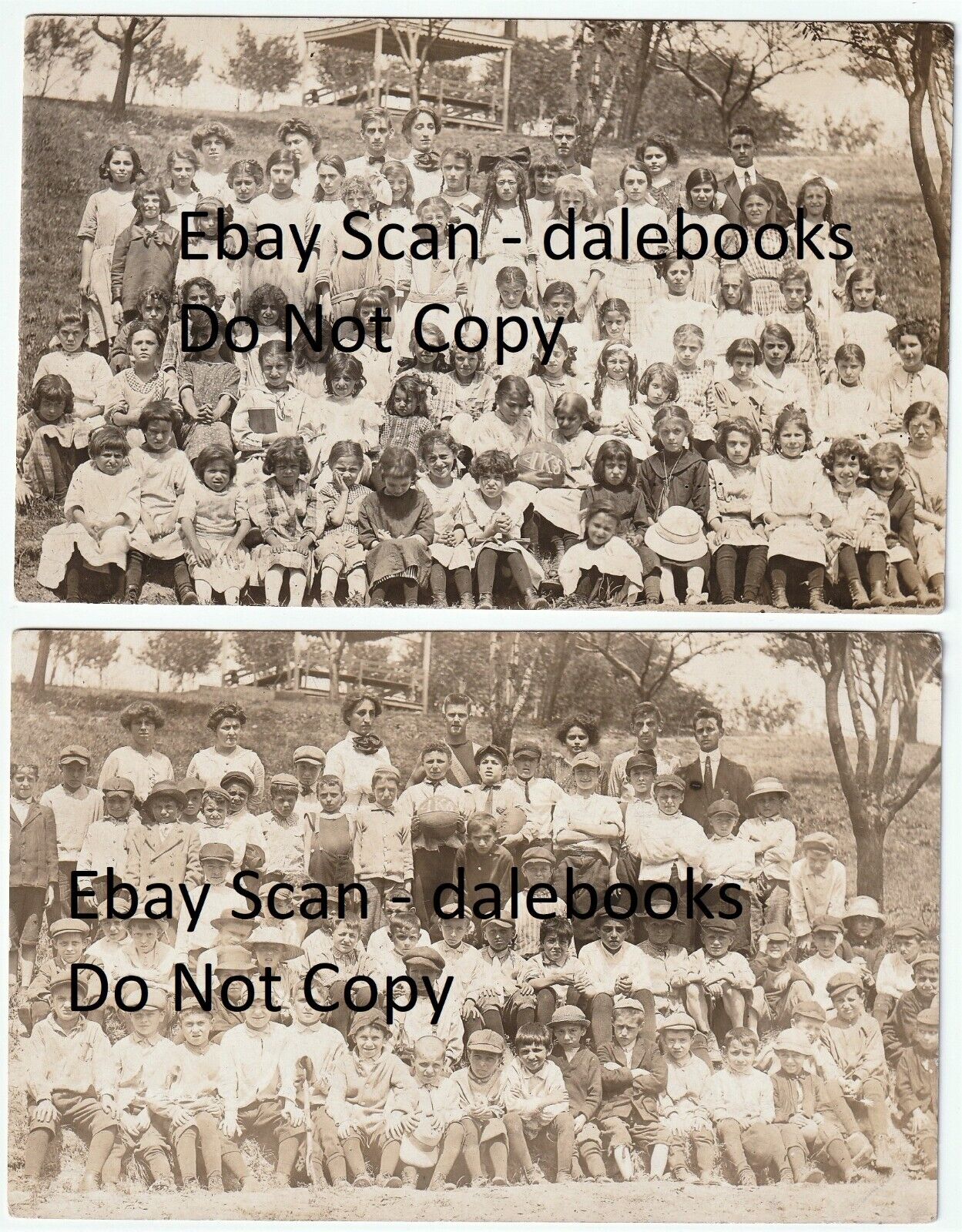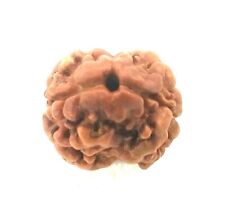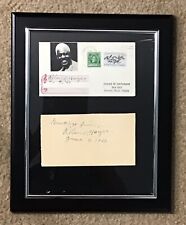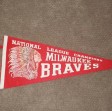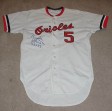When you click on links to various merchants on this site and make a purchase, this can result in this site earning a commission. Affiliate programs and affiliations include, but are not limited to, the eBay Partner Network.
SUPER - RARE Original - Old Real Photograph PostcardsONE OF A KINDIrene Kaufmann Settlement - IKS
Camp - Emma Farm ?
Pittsburgh, Pennsylvaniaca 1915
For offer - a very nice old Postcard lot! Fresh from an estate in Upstate NY. Never offered on the market until now. Vintage, Old, antique, Original - NOT a Reproduction - Guaranteed !! Nice scenes. These are unique images, one of a kind. Each photo shows group of children, with one in center holding a ball with IKS on it. Message on back talks about children coming to the camp. In good to very good condition. Please see photos. If you collect postcards, 20th century history, American history, Americana, occupational,etc., this is a nice one for your paper or ephemera collection. 3083
Irene Kaufmann Settlement (IKS), known as the Columbian School and Settlement from 1895 to 1910, was a settlement house located in Pittsburgh, Pennsylvania, US, at 1835 Center Avenue. It was the idea of Pauline Hanauer Rosenberg and established by the Columbian Council (now known as the National Council of Jewish Women - Pittsburgh Section) for moral, educational, and religious training. \"The special purposes of the Settlement is the advancement of the civic, intellectual and social welfare of the surrounding community. It aims to do this (1) by guiding the foreign-born to American conditions, (2) encouraging self-improvement, (3) stimulating healthy pleasures, (4) broadening civic interests, (5) creating ideals of conduct. The place is a home in the life of its residents, an institution in the service of its friends, a school in the work of its teachers, a club house in the social uses of its neighbors, a civic organization in the interests of the community, a Settlement in the choice of its location\".[1]
Irene Kaufmann Settlement, junior basketball team, Dec. 1929
At the geographical center of the Lower Hill District (Pittsburgh\'s most populous district at that time), the IKS made its service available to anyone who needed its aid. It coordinated services with the Jewish Federated Philanthropies, the Municipal Safety and Health Departments, the Labor Bureau of the Council of Jewish Women, the public schools, the Associated Charities, the Juvenile Court, the Housing Commission, and the Emma Farm. The IKS housed under its roof 17 outside organizations, including various trade unions and socialist groups. It maintained a public bath and public laundry, and a summer camp.
It had a resident staff of seven; additionally, 170 volunteers gave one or more hours each week to some form of social service in the district. The property of the Irene Kaufmann Settlement covered an area of 200 by 60 feet (61 m × 18 m). The settlement building was erected in 1910. It was of steel frame construction with yellow brick, and five stories high. There were 67 rooms in the main building, and a gymnasium and public bath in the rear, that building being known as the Peacock Public Bath. The settlement building was dedicated March 29, 1911. It was a monument to the memory of Irene Kaufmann, daughter of Mr. and Mrs. Henry Kaufmann, owners of Kaufmann\'s Department Store, one of the largest stores in Pittsburgh. Miss Kaufmann died in 1907.[1][2][3]
See also
History of the Jews in Pittsburgh
Settlement and community houses in the United States
Pittsburgh (/ˈpɪtsbɜːrɡ/ PITS-burg) is a city in the Commonwealth of Pennsylvania and the county seat of Allegheny County. It is the most populous city in both Allegheny County and Western Pennsylvania, the second-most populous city in Pennsylvania after Philadelphia, and the 68th largest city in the U.S. with a population of 302,971 as of the 2020 census. The city anchors the Greater Pittsburgh metropolitan area of Western Pennsylvania; its population of 2.37 million is the largest in both the Ohio Valley and Appalachia, the second-largest in Pennsylvania, and the 27th-largest in the U.S. It is the principal city of the greater Pittsburgh–New Castle–Weirton combined statistical area that extends into Ohio and West Virginia.
Pittsburgh is located in southwest Pennsylvania at the confluence of the Allegheny River and the Monongahela River, which combine to form the Ohio River.[5] Pittsburgh is known both as \"the Steel City\" for its dominant role in the history of the U.S. steel industry, and as the \"City of Bridges\" for its 446 bridges.[6] The city features 30 skyscrapers, two inclined railways, a pre-revolutionary fortification and the Point State Park at the confluence of the rivers. The city developed as a vital link of the Atlantic coast and Midwest, as the mineral-rich Allegheny Mountains led to the region being contested by the French and British empires, Virginians, Whiskey Rebels, and Civil War raiders.[7]
Aside from steel, Pittsburgh has led in the manufacturing of other important materials—aluminum and glass—and in the petroleum industry. Additionally, it is a leader in computing, electronics, and the automotive industry.[8] For part of the 20th century, Pittsburgh was behind only New York City and Chicago in corporate headquarters employment; it had the most U.S. stockholders per capita.[9] Deindustrialization in the 1970s and 1980s laid off area blue-collar workers as steel and other heavy industries declined, and thousands of downtown white-collar workers also lost jobs when several Pittsburgh-based companies moved out.[10] The population dropped from a peak of 675,000 in 1950 to 370,000 in 1990. However, this rich industrial history left the area with renowned museums, medical centers,[11] parks, research centers, and a diverse cultural district.[12]
After 1990, Pittsburgh transformed into a hub for the health care, education, and technology industries.[13] Pittsburgh is home to large medical providers, including the University of Pittsburgh Medical Center (UPMC), and 68 colleges and universities, including research and development leaders Carnegie Mellon University and the University of Pittsburgh.[14] Google, Apple, Bosch, Meta, Nokia, Autodesk, Amazon, Microsoft, and IBM are among some 1,600 technology firms with a presence in the city, generating $20.7 billion in annual Pittsburgh payrolls.
Federal money has supported the research agenda. The area has served as the federal agency headquarters for cyber defense, software engineering, robotics, energy research and the nuclear navy.[15] The nation\'s fifth-largest bank, eight Fortune 500 companies, and six of the top 300 U.S. law firms make their global headquarters in the area, while RAND Corporation (RAND), BNY Mellon, Nova, FedEx, Bayer, and the National Institute for Occupational Safety and Health (NIOSH) have regional bases that helped Pittsburgh become the sixth-best area for U.S. job growth.[16]
In 2015, Pittsburgh was listed among the \"eleven most livable cities in the world\" by Metropolis magazine.[17][18] The Economist\'s Global Liveability Ranking placed Pittsburgh as the most or second-most livable city in the United States in 2005, 2009, 2011, 2012, 2014, and 2018.[19][20] The region is a hub for Leadership in Energy and Environmental Design and energy extraction.[21]
The Emma Farm Association was created to “maintain a farm in order to provide open-air recreation for children and adults and a temporary home for convalescents.” The Association was organized by a group of 33 community leaders on May 19, 1908, after Isaac and Morris Kaufmann purchased a small farm in Harmarville, Pa. for such purposes. The association was named for Isaac Kaufmann’s late wife Emma Kaufmann.
Although its sponsors and leadership came from the Jewish community, and it observed the Jewish dietary laws of kashrut at its facilities in an attempt to make the camp accessible to Orthodox members of the community, the Emma Farm Association was non-denominational and non-sectarian. In its early years, the Irene Kaufmann Settlement House, the Soho Baths Settlement, the Woods Run Industrial Home, and the United Hebrew Relief Association all referred children to the Emma Farm. The Emma Farm initially included a Farm School Department to oversee programs for juvenile delinquents and a Fresh Air Department to provide recreation for children and families.
The Emma Farm Association was one of the original beneficiaries of the Federation of the Jewish Philanthropies of Pittsburgh. Initially independent, the Emma Farm Association partnered with the Irene Kaufmann Settlement House in 1916 to provide management. Several changes were implemented under the new management arrangement, such as the introduction of enrollment fees, the elimination of private dining halls for staff, and steps to eliminate food waste and reduce overcrowding. The Farm School Department was dropped in 1918 to devote resources to the Emma Farm Camp.
To accommodate growth, the Emma Farm Camp relocated in the early 1920s to a site along the Connoquenessing Creek between Zelienople, Pa. and Harmony, Pa. The Emma Farm Association was part of a larger network of “fresh-air” camps across the country, and it evolved over the years along with wider changes in the field. The Emma Farm Association revised in bylaws in 1922. It made a series of changes in the 1940s designed to implement emerging best practices from the American Camping Association. In these years, the organization began increasingly using the name Emma Kaufmann Camp.[1]
Following a two-year study overseen by the United Jewish Federation, the Emma Farm Association merged with the Irene Kaufmann Center and the Young Men’s and Women’s Hebrew Association in 1961. As part of the merger, the Laurel Y Camp merged its operations into the Emma Farm Camp. Emma Kaufmann Camp acquired the 200-acre Camp Lynnwood near Morgantown, W.Va. in 1971 and relocated the following year.[2]


